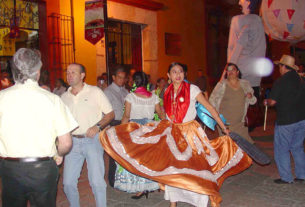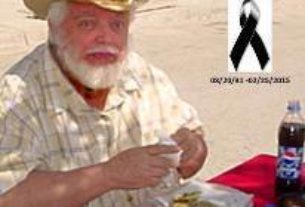Did You Know…?
Juan O’Gorman was born on July 6, 1905, in Coyoacán, Mexico City. His father, Cecil Crawford O’Gorman, was a mining engineer and artist of Irish origin; his mother was Mexican. Juan was educated at the National University (UNAM), and became a well known architect.
A follower of the Franco-German rationalism school, he was one of first Mexican architects to break with traditional Mexican style. His first experiment in this regard was the home of Cecil O’Gorman in 1929, where the influence of the legendary French architect Le Corbusier was apparent. At about the same time, O’Gorman built the home-with-studios of Diego Rivera and Frida Kahlo. These buildings were among the first examples of functionalist architecture in Mexico.
But O’Gorman was not only an architect. He was also a distinguished painter and muralist. His largest, and perhaps his most-viewed work, is the monumental mosaic on the walls of UNAM Library (1953). This is the world’s largest mural! More than three million pieces of naturally-colored stones and glass, each less than five centimeters (about two inches) in diameter, cover 3,712 square meters (43,000 square feet) of wall. The mural took two years to complete and covers all four walls. The north side shows the pre-Hispanic cultures, the south the conquest of Mexico. Social struggles are represented on the east side and the university shield on the west side.
His more conventional murals include those in the Independence Room in Mexico City’s Chapultepec Castle, and a magnificent mural in the library of Pátzcuaro, Michoacán (see images and detailed description below).
The current exhibition of his paintings and drawings includes several self-portraits, the most remarkable of which is “Multiple Self-Portrait,” consisting of no fewer than four self portraits in a single picture. The artist paints himself painting himself painting….
Among his other portraits, those of fellow muralists Diego Rivera and José Clemente Orozco stand out. The items in the exhibition are extraordinarily varied in style, ranging from earlier conventional landscapes to enormously complex fantasies, inspired by Salvador Dali. Frequent flyers will recognize another of O’Gorman’s masterpieces, “The Conquest of Air by Man” (1937), normally on show at Mexico City airport, which tells the history of flight from birds, to Da Vinci’s wing designs, to modern planes.
In later life, O’Gorman returned to architecture, inspired by the works of Frank Lloyd Wright. He died in Mexico City in 1982 at the age of 77.
Where To Go
The centenary exhibition of about 150 of Juan O’Gorman’s finest works is on show until October at the Banamex offices in the former Iturbide Palace, Madero 17, in downtown Mexico City. The exhibition is open daily, except Tuesdays, from 10.00 a.m. to 7.00 p.m.
The Pátzcuaro library mural
On the north side of the small plaza (Gertrudis Bocanegra square) in central Pátzcuaro is the former San Agustín church, now converted into a library. This library houses a magnificent mural painted by Juan O’Gorman. Begun in February 1941, the mural was finished in February 1942, one year before the eruption began of nearby Paricutín volcano. Nevertheless, prophetically, O’Gorman depicts a volcano in full eruption near the top of the mural. Like most murals in Mexico, this one tells the history of the local area.
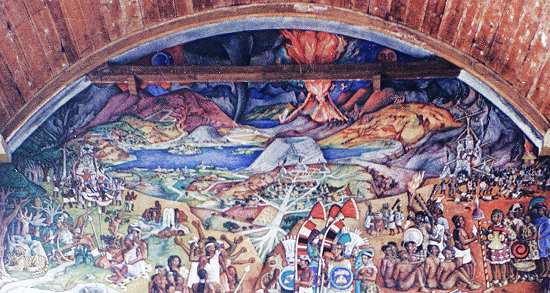
Near the top, are The Sun and The Moon, representing the Purepecha deities, Huriata and Cutzi respectively, who gave life to the plants and watched over the night. A waterspout is depicted. According to legend, after volcanic eruptions in the Sierra, this waterspout gave rise to the lakes of Pátzcuaro, Zirahuén and Cuitzeo. Near Lake Pátzcuaro are shown several temple bases (yácatas) like those at Tzintzuntzan, with a “tree” of routes leading to them.
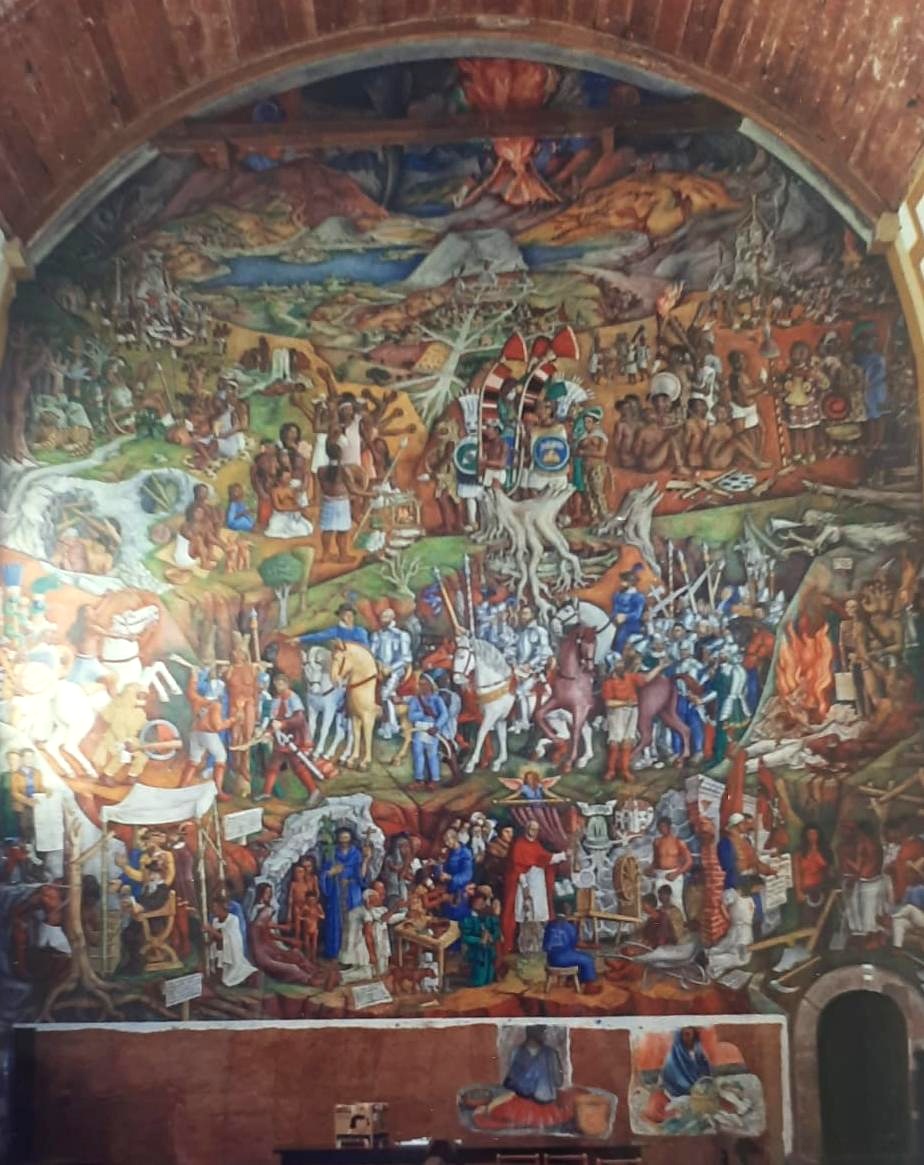
Aspects of indigenous life and customs, such as agriculture, hunting, trading and prisoners of war are shown, together with ritual bathing and mining. One miner is shown being carried out of the mine having been overcome by the poisonous fumes.
From the right, the Spaniards arrive, led by the allegedly barbarically cruel Nuño Beltran de Guzmán. They attempt to destroy the Purepecha culture, but it survives in a “mummified” form. The native American princess Erendira, the first Indian woman to ride a horse, breaks the siege of Pátzcuaro and rides for help from people living in nearby settlements and on the islands. A feminine Paul Revere! But her efforts are in vain and the Purepecha are tricked into surrender.
Elsewhere, scenes suggest the good and the bad sides of the Conquest. Overlooking the Spanish Inquisition, and a bonfire of Indian idols and codices, is a surrealist figure of a grotesque hand-with-eyes, symbolizing an empty head, a brain that doesn’t think, an intelligence without control, an invasion.
The good is shown by several priests who brought education and crafts. They include, in a white tunic and red cloak, the first Bishop of Michoacán, Vasco de Quiroga, who had been influenced by the Utopian ideas of Thomas More. Vasco de Quiroga introduced large fishing nets and encouraged many crafts.
Careful study of the faces of those accompanying the invading Spanish forces will reveal portraits of Mussolini and Hitler. The Conquistadors, Fascists and Nazis are all considered equals…
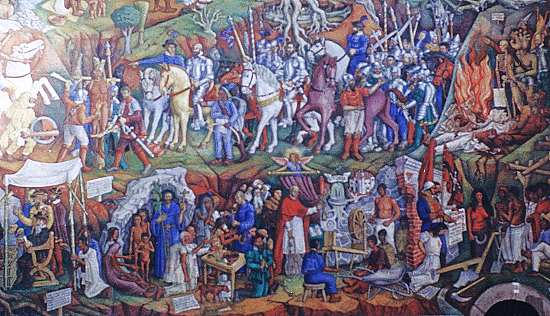
The bottom right hand corner depicts José María Morelos, the Independence leader, author of Mexico’s first constitution with its slogan “Independence and freedom for all the peoples of America.” Next to him is Emiliano Zapata, the Revolutionary hero, with his slogan, “Land and Liberty.” Kneeling down is Gertrudis Bocanegra, the local heroine from Mexico’s struggle for Independence, executed for her troubles.
On the left hand side (not shown in the image), O’Gorman could not resist drawing himself, wearing glasses, together with his wife. He holds a scroll which proclaims the future day of redemption for Mexican Indians and the release of a “great force which will explode like a gigantic volcano in eruption” to produce “extraordinary art and culture.” Close by is a jester with a sign saying “That’s life”.
All in all, a fitting monument to a great artist, born exactly 100 years ago this year.
Text and all photos © Copyright 2005 by Tony Burton. All rights reserved.

